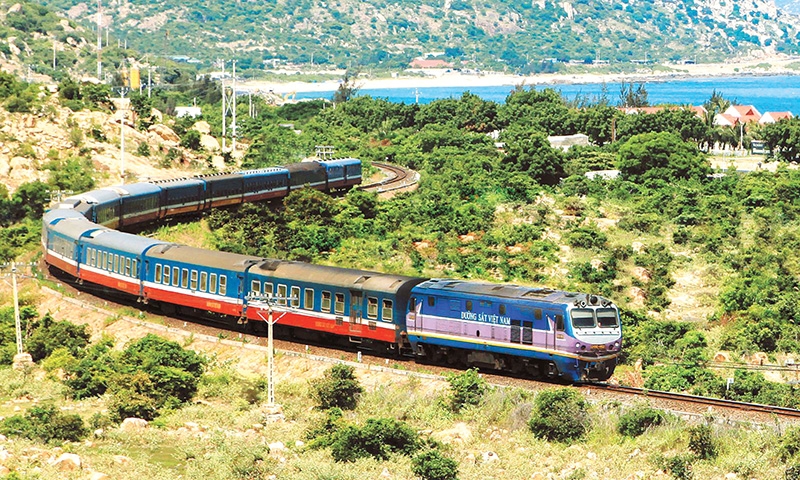Transport enterprises adjust to grab profits
 |
| Across rail, road, air, and sea, transport groups are diversifying services to circumvent pandemic impacts, photo Le Toan |
According to Nguyen Chinh Nam, director of the Planning and Business Department at wholly state-owned Vietnam Railways (VNR), in the face of the drop in passenger transport, the railway industry strengthened cargo operations, including two-way international transport.
“Railway transport firms have diversified their products and services for international transport to attract customers. They now include self-powered reefer container trains to haul frozen products and fruit for import-export,” he added.
Railway Transport and Trade JSC (Ratraco), a member unit of VNR focusing on cargo transport, is one of the companies enjoying success during this time. Nguyen Hoang Thanh, deputy director of Ratraco, said that his company is working to replace by-transit cargo trains with trains from Thailand and Laos to China, and then from China to Cambodia and vice versa. It is also working to transport less-than-container load cargo from Russia to Vietnam, with the first train to run in late September.
According to VNR statistics, the group handled over 5.37 million tonnes of cargo last year, up 4.7 per cent on-year, while cargo revenue ascended 7.7 per cent on-year to VND1.56 trillion ($67.83 million). With the improvements in the cargo segment, VNR’s losses and dropping revenues were partly offset. The giant ended 2020 with an estimated loss of VND1.33 trillion ($57.83 million) while its consolidated revenue reached VND6.56 trillion ($285.2 million) during the year, equal to 78.3 per cent of the year earlier.
The railway route from Vietnam to Russia, Central Asia, and Europe with transit in China and Kazakhstan is often referred to as the Silk Road. In addition, other potential railway routes include the direct China-Russia-Europe and the China-Mongolia-Russia-Europe routes.
In the maritime industry, the country’s shipping giant Vietnam Maritime Corporation (VIMC) has been venturing into customised services to adapt to the global health crisis in 2020, when it has begun to operate as a joint-stock company since September 1, 2020.
Tran Tuan Hai, head of Communiations at VIMC told VIR, “Instead of pouring money into expanding operations or projects the way we did in the past, we focused on upgrading and maintaining devices, and applying IT solutions to better service customers.”
“In the shipping business, we have been focusing on routes to countries and areas that were hit less by COVID-19. Southeast Asia and Asia were among our key markets during the year,” he added.
The changes enabled the shipping giant to make a profit of over VND1 trillion ($43.5 million) throughout the year, despite the pandemic.
As the industry leader, VIMC currently has 35 member companies, managing and operating over 13,000 metres of piers, accounting for nearly 30 per cent of the country’s total, capable of handling over 100 million tonnes of cargo (over 20 per cent of the country’s total). Its key seaports include Haiphong Seaport, Saigon Seaport, Danang Seaport, Quy Nhon Seaport, and the Cai Mep-Thi Vai port area.
Following the trend, Airports Corporation of Vietnam (ACV), state-run Vietnam Expressway Corporation (VEC), and national flag carrier Vietnam Airlines have also taken action to withstand the disruptions of the year.
For instance, Vietnam Airlines has been turning towards domestic travellers by launching special promotional programmes and opening more domestic flights, while waiting for the resumption of international flights.
According to statistics from Vietnam Airlines, it conducted 46,700 flights in the first three quarters of 2020 with a total of nearly 11.9 million passengers and 146,000 tonnes of cargo. Dang Anh Tuan, head of Vietnam Airlines’ Communications Department, said that during the 2020 summer season when the pandemic was successfully controlled, Vietnam Airlines opened 22 new air routes.
This resulted in a quarterly increase in the passenger segment. As a result, the airline estimated that the parent company incurred a loss of over VND12 trillion ($521.74 million) last year, about VND2.42 trillion ($105.2 million) lower than the estimation made in August.
Looking towards 2021, leaders said that VNR will continue to focus on cargo trains. Vietnam Airlines continues launching promotional programmes to stimulate travelling demands, while ACV and VEC will focus on key national projects, which are part of the country’s plans to accelerate public investment to create a driving force for socioeconomic development.
Experts, however, warned that more efforts and changes are required among the giants as exactly how the pandemic will go down remains uncertain in the coming months.
What the stars mean:
★ Poor ★ ★ Promising ★★★ Good ★★★★ Very good ★★★★★ Exceptional
Related Contents
Latest News
More News
- Global partnerships key to Vietnam’s IFC development (December 26, 2025 | 16:18)
- Vingroup pulls out of bid to invest in North-South high-speed railway (December 26, 2025 | 11:42)
- Strengthening supply chains through trade promotions and customs reform (December 24, 2025 | 14:00)
- PM orders investment model for North–South high-speed rail (December 22, 2025 | 17:43)
- LS Eco Energy to invest in Vietnam rare earth sector (December 22, 2025 | 17:31)
- Government moves to establish International Financial Centre (December 21, 2025 | 21:00)
- Vietnam's IFC to target global investment flows (December 21, 2025 | 18:00)
- Two national hospitals expand capacity with new facilities (December 20, 2025 | 09:00)
- Ha Tinh breaks ground on major Vingroup industrial and energy projects (December 19, 2025 | 18:24)
- EVN launches major power infrastructure projects nationwide (December 19, 2025 | 18:17)

 Tag:
Tag:





















 Mobile Version
Mobile Version